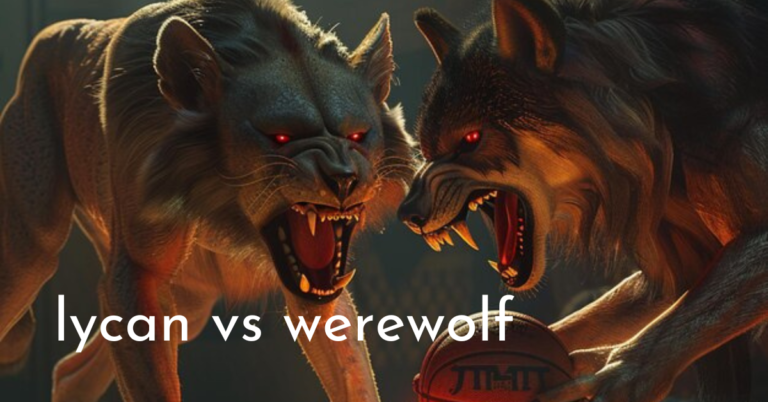Introduction to Lycans vs Werewolves
The moon hangs high in the night sky, casting an eerie glow over the landscape. Shadows dance across the ground as legends of ancient creatures come to life. Among these formidable beings are lycan vs werewolf—two supernatural entities that have sparked intrigue for centuries.
Fans of fantasy and horror often find themselves drawn into their captivating stories. But what sets them apart? Are they merely different names for the same creature, or do they embody unique traits and lore? This blog post takes you on a thrilling journey through the world of Lycans and Werewolves, exploring their origins, abilities, pop culture representations, and ultimately determining which creature reigns supreme in this ultimate showdown. Buckle up; it’s going to be a wild ride!
The Origin of Lycans vs Werewolves
The origin of lycan vs werewolf is steeped in folklore and myth. Ancient civilizations, from the Greeks to the Norse, spun tales of humans transforming into wolves under the full moon’s glow.
These creatures were often linked to curses or divine punishment. In some stories, a simple bite could seal one’s fate, turning them into a beast. Others depicted rituals that granted individuals this fearsome power.
The term “lycan” comes from Lycanthropy—an affliction where one believes they can shape-shift into an animal. This concept has evolved over centuries.
Interestingly, while both share roots in transformation myths, their narratives diverge significantly across cultures. Some portray Lycans as more civilized beings with control over their powers, whereas Werewolves are cast as monstrous entities driven by primal instincts.
This rich tapestry of legends continues to inspire writers and filmmakers today.
Similarities and Differences between Lycans and Werewolves
lycan vs werewolf share a rich heritage in folklore, both transforming from human to beast under the moonlight. They evoke fear and fascination, captivating audiences for centuries.
Despite their similarities, they differ significantly in nature. Lycans are often depicted as more civilized. They can control their transformation at will and retain human intelligence during these changes. In contrast, werewolves typically lose themselves to primal instincts when they shift.
Their origins also set them apart. While werewolves trace back to ancient European lore linked with curses or bites, Lycans emerged primarily from modern interpretations in books and films that emphasize their hybrid lineage.
Both creatures possess unique traits but reflect humanity’s struggle between savagery and civility—a theme that resonates deeply across cultures. Their narratives explore the duality of man while igniting our imagination about what lies beneath the surface of ordinary life.
Abilities and Weaknesses of Lycans vs Werewolves
Lycans vs werewolves both possess formidable abilities that make them fearsome creatures of the night. Lycans are known for their transformation at will, allowing them to retain human intelligence while in wolf form. This gives them an edge in strategy and cunning during confrontations.
On the other hand, traditional werewolves often undergo involuntary transformations driven by the full moon’s power. Their strength is immense, but they lack control during these nights, leading to chaotic rampages.
When it comes to weaknesses, silver is a common vulnerability for both entities. A weapon forged from this precious metal can cause severe damage or even death.
Additionally, lycans may be susceptible to certain spells or enchantments aimed specifically at shapeshifters. Werewolves can also struggle with emotional turmoil post-transformation, leaving them vulnerable in moments of reflection or regret.
Famous Examples of Lycans and Werewolves in Pop Culture
Pop culture is rich with portrayals of both Lycans and werewolves, each offering distinct flavors to the narrative.
In the “Underworld” series, Lycans are depicted as a more sophisticated breed. They showcase strength and intelligence while battling vampires in a darkly beautiful world. Their fierce loyalty adds depth to their character.
On the other hand, classic films like “The Wolf Man” highlight traditional werewolf lore. Lon Chaney Jr.’s portrayal captures the tragic struggle between humanity and beast within. This film set the standard for many representations that followed.
More recently, shows like “Teen Wolf” give a modern twist on werewolves. Here, they blend teenage angst with supernatural challenges, making them relatable yet thrilling.
Video games also join this fray; titles like “The Witcher” present compelling lycanthropic characters that add complexity to gameplay and storylines. Each medium brings its unique interpretation of these fascinating creatures.
The Debate: Which is the Superior Creature?
When it comes to lycans versus werewolves, the debate rages on. Each side boasts dedicated followers, passionately defending their chosen creature.
Lycans often edge out in discussions around intelligence and control. With an ability to transform at will, they retain human consciousness during their transformations. This gives them a strategic advantage.
On the other hand, werewolves are raw power incarnate. Their sheer brute strength and primal instincts make them formidable opponents in any scenario. Many argue that this untamed ferocity is what makes them truly terrifying.
Fans also highlight lore differences as pivotal points in this rivalry. Some see lycans as tragic figures caught between two worlds, whereas werewolves represent unbridled chaos and freedom from societal constraints.
At the heart of the discussion lies personal preference; whether one values cunning over savagery or elegance over brutality defines which creature reigns supreme in individual hearts.
Conclusion: Why We Love Lycans vs Werewolves in Fiction
lycan vs werewolf continue to captivate our imaginations. These creatures embody the allure of the unknown, representing both primal instincts and complex human emotions. They challenge us, reflecting our fears and desires in a world that often feels chaotic.
Their stories weave together themes of transformation, acceptance, and struggle. We are drawn to their battles—both internal and external—as they navigate their dual identities. The conflict between humanity and beast resonates deeply within us all.
Whether it’s through films, books, or folklore, these mythical beings invite us into a realm where anything is possible. Their presence sparks conversations about nature versus nurture, freedom versus restraint. It’s this blend of horror with empathy that keeps fans returning for more tales.
Lycans and werewolves are not just monsters; they are mirrors showing us who we might be when faced with our own shadows. This connection makes them timeless figures in fiction—a testament to why we love exploring their worlds again and again.
FAQs
1. What is “Lycan vs Werewolf”?
“Lycan vs Werewolf: The Ultimate Showdown” is an exploration of two mythical creatures, Lycans and Werewolves, often featured in folklore and popular culture. This article delves into their origins, abilities, and differences, comparing their roles and characteristics to determine which creature holds more appeal or power.
2. How do Lycans differ from Werewolves in terms of transformation?
Lycans can transform at will, maintaining their human intelligence and control during their wolf form. In contrast, traditional werewolves typically undergo involuntary transformations driven by the full moon, often losing control and succumbing to primal instincts.
3. What are some notable weaknesses of Lycans and Werewolves?
Both Lycans and Werewolves are vulnerable to silver, which can cause severe damage or death. Additionally, Lycans may be affected by specific spells or enchantments aimed at shapeshifters, while Werewolves can experience emotional vulnerability post-transformation.
4. Can you give examples of how Lycans and Werewolves are portrayed in popular culture?
Certainly! In the “Underworld” series, Lycans are depicted as intelligent and strategic fighters. Traditional Werewolves are famously portrayed in films like “The Wolf Man,” which highlights their tragic struggle. More modern interpretations include shows like “Teen Wolf” and games like “The Witcher,” which offer fresh takes on these creatures.
5. Which creature is considered superior, Lycans or Werewolves?
The debate over which is superior often comes down to personal preference. Lycans are praised for their intelligence and control, while Werewolves are admired for their raw power and primal ferocity. Each has its strengths and appeal, making the “superior” creature a matter of individual perspective.

